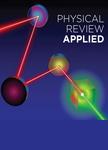版权所有:内蒙古大学图书馆 技术提供:维普资讯• 智图
内蒙古自治区呼和浩特市赛罕区大学西街235号 邮编: 010021

作者机构:IITB Monash Research Academy Indian Institute of Technology Bombay Mumbai Maharashtra 400076 India Faculty of Engineering and Environment Smart Materials and Surfaces Laboratory Northumbria University Newcastle upon Tyne NE1 8ST United Kingdom Department of Mechanical Engineering Suman Mashruwala Advanced Microengineering Laboratory Indian Institute of Technology Bombay Mumbai Maharashtra 400076 India Laboratory for Micro Systems Mechanical and Aerospace Engineering Monash University—Clayton campus Melbourne Victoria 3800 Australia
出 版 物:《Physical Review Applied》 (Phys. Rev. Appl.)
年 卷 期:2018年第10卷第2期
页 面:024036-024036页
核心收录:
基 金:STFC [ST/J003697/2] Funding Source: UKRI
主 题:Acoustic interactions Granular flows Microfluidic devices Capillary waves
摘 要:We present a device to continuously focus microparticles in a liquid-filled open channel subjected to lateral vibration at frequencies of the order of 10 Hz. The vibration generates a capillary wave at the liquid-air interface. This capillary wave leads to a net motion of microparticles over multiple cycles, causing collection under the displacement nodes of the capillary wave. These accumulated particles are observed as a concentrated stream in the presence of a continuous flow along the open channel, which means that the channel can be designed such that the focused particle stream exits through one outlet, while the filtrate is removed via interspaced outlets on each side of the particle stream. A numerical model is proposed, which superimposes the periodic flow field due to the capillary wave and the inlet-induced transverse flow field between the inlet and the outlet. The model is utilized to predict the smallest distance from the inlet at which the focused stream of particles is obtained, termed here the collection length. In addition, experiments are performed for different channel and inlet sizes, vibration actuation amplitudes, flow rates, and particle sizes. By considering the design factors extracted from the modeling data, we demonstrate that the resulting device is capable of continuous particle collection down to 1μm diameter, at flow rates of up to 1.2 ml/min.